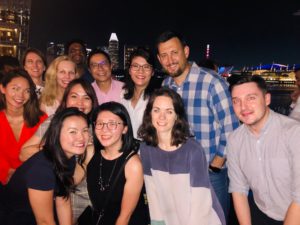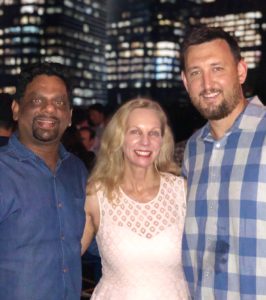Telum Talks To… Emma Thompson, Managing Partner, Spurwing Communications & Kirsten Bruce, Principal, VIVA! Communications
Telum recently chatted with Emma Thompson from Spurwing Communications in Singapore and Kirsten Bruce from Australia’s VIVA! Communications about their agencies and being part of global agency partnership GLOBALHealthPR.
Can you tell us more about GLOBALHealthPR and how the network operates?
Kirsten: GLOBALHealthPR (GHPR) is the world’s largest partnership of independently owned health and science communication agencies. Our global network enables us to successfully coordinate culturally-sensitive PR campaigns of local, regional and global orientation for leverage in major Asia Pacific, American, Latin American and European markets. What is so unique about our partnership, is that all partners have an extensive understanding of the cultural sensitivities of their respective local markets, the local regulatory industry frameworks and are connected to local clients and media.
culturally-sensitive PR campaigns of local, regional and global orientation for leverage in major Asia Pacific, American, Latin American and European markets. What is so unique about our partnership, is that all partners have an extensive understanding of the cultural sensitivities of their respective local markets, the local regulatory industry frameworks and are connected to local clients and media.
We constantly share invaluable insights and resources to best service our local, regional and global clients. We respond to global and regional RFPs under the GLOBALHealthPR brand, with specifically tailored contracts. Furthermore, we represent a genuine alternative to the traditional holding company model. Our current network comprises more than 600 healthcare communication specialists worldwide.
What are the benefits and challenges of working in an agency network like this?
Kirsten: Our partnership enables us to learn from, and consistently share examples of best practice and innovative ideas; to stay abreast of industry challenges, whether local, regional or global; and to meet in person to develop strategy, and share common successes and challenges at regional and global meetings.
Working in different healthcare-related markets, particularly throughout Asia Pacific, poses various challenges, including a plethora of regulatory codes of conduct, stakeholder politics and the like. What often works in one market may not work in another. Being able to rely on our market-specific partners enables us to produce strategic communication programmes tailored to the specific needs of our clientele.
Emma: Being based in Singapore, the regional hub for many of our healthcare clients, means we are often working on projects that impact the entire region. By being part of GHPR we know that, should we need to offer regional support to our clients, we are connected to teams that can respond quickly and deliver a calibre of work that our clients expect.
10 years ago, the challenge would have been not seeing enough of each other, but Zoom and Skype mean we “meet” at least once a month on a global and regional network level – more regularly than many of our “networked” peers.
What is the process in developing news for each market? Is there a lot of localisation that happens?
 Kirsten: Australian news media (medical and consumer) is an established and relatively sophisticated media, well-versed in hard news. So, the strategic packaging of a compelling news story in order to generate cut-through is critical. From a consumer news media perspective, it is important that Australian key opinion leaders, supporting stakeholders and patients work in partnership to deliver consistent, agreed key messages and a strong call-to-action in order to drive awareness, and if required, action.
Kirsten: Australian news media (medical and consumer) is an established and relatively sophisticated media, well-versed in hard news. So, the strategic packaging of a compelling news story in order to generate cut-through is critical. From a consumer news media perspective, it is important that Australian key opinion leaders, supporting stakeholders and patients work in partnership to deliver consistent, agreed key messages and a strong call-to-action in order to drive awareness, and if required, action.
Together with our partners, we are often called upon to develop materials for market-specific localisation throughout the region. These materials must be carefully crafted for each market, to enable consistent relaying of local messages, while adhering to specific regulatory codes of conduct, and allowing for translation into local languages.
What does working in a global partnership mean for your clients? Have their expectations changed because of this?
Emma: The majority of our clients are already multi-national companies and the regional teams we work with operate as part of a global agenda. Being part of the GHPR network helps us to demonstrate to them that we understand global communications trends and can support them in tailoring these trends for meaningful regional engagement.
At Spurwing, we also work with some of the leading Asian biotechs and medtech startups, helping them to establish their profiles ahead of key regulatory updates, financing milestones and often preparing to list on global exchanges. It is reassuring for us, and them, to know that when they are ready to build their profiles in other regions, there is a network of experts ready to support them.
Kirsten: As an independent health and wellness communications agency operating as the hub lead for GHPR in Asia Pacific, this places VIVA! Communications in a truly unique position. Our clients are often thrilled to learn of the “proactive” role we play in GHPR, which not only elevates us beyond our local market, but also adds significant value to our clientele.
How have the health and life science sectors changed in the past decade across APAC, and Where do you see the industry going from here?
Emma: Home to the majority of the world’s population, rapidly increasing affluence and an aging population, Asia is the growth market for the future of healthcare. Equal to the region’s incredible opportunity is its diversity, with very mature markets such as Japan and Singapore, through to huge emerging opportunities such as China and India. We only expect interest in the region to grow as large markets such as China begin to adjust regulatory processes, improving market access for multinationals and truly innovative new treatments.
We are seeing this opportunity leading to the development of a growing biotech startup scene looking to tap this market. These new companies have grand ambitions to solve some of the biggest healthcare challenges in the region, and we are helping them to communicate this to their stakeholders.
Kirsten: Thanks to advancing technology, the Australian healthcare industry is undergoing rapid transformation. Keeping pace with this change from a communications perspective, is, and will continue to be, critical to success.
The industry will increasingly look to appoint agencies with proven expertise in delivering strategic, fully integrated communication campaigns that navigate a plethora of relevant and often complex, market-specific regulatory codes of conduct, while maintaining interest, newsworthiness and engagement. Storytelling and content curation will be king.
What are the current news trends in the sector?
Emma: 2018 has been a remarkably successful year for healthcare, outperforming the expectations of many analysts. With a global aging population driving demand and strong company balance sheets, financial news in the sector this year has been widely positive.
We have also seen a shifting media narrative around the application of healthcare. “Personalisation” and the role of new technologies in healthcare have certainly become trends. The topic of personalised healthcare has been part of a wider discussion in the media around the future of technology in the sector. The industry is looking for ways to become more efficient and improve access. Robotics, 3D printing and big data tech, such as Google DeepMind, have all grabbed headlines for their roles in redefining care and improving operational efficiencies.
Mistrust in the health sector is rising among the general public. How are you combating this and getting your message out to your audiences?
Emma: Healthcare is a human industry, which is why it gets so much attention from the general public. Seeing the positive impact that healthcare companies can have on the lives of patients is  incredibly moving. We work with clients to ensure people see the transformational impact healthcare companies are having on society.
incredibly moving. We work with clients to ensure people see the transformational impact healthcare companies are having on society.
Increasingly, the public are looking at company leaders when deciding if they trust an industry. Through training and impactful messaging, we equip leaders to build trust with the communities in which they operate. Whether in the media or online, having a public profile will be critical for all leaders to build trust going forward.
Kirsten: The health sector should exercise transparency and empathy in all of its communication with the general public. Without the general public, the health sector would largely be null and void.
At VIVA! Communications, we spend a significant amount of time at campaign outset developing an extensive, fully referenced, umbrella key message document from which all campaign media materials fall. Importantly, this document also includes an issues management message section containing responses to real or perceived issues in order to allay audience fears or to debunk myths. We pride ourselves on forging honest relationships with key health-related stakeholders with whom we share common ground, and wish to work, to deliver factual information (no matter how challenging) to our target audiences.
